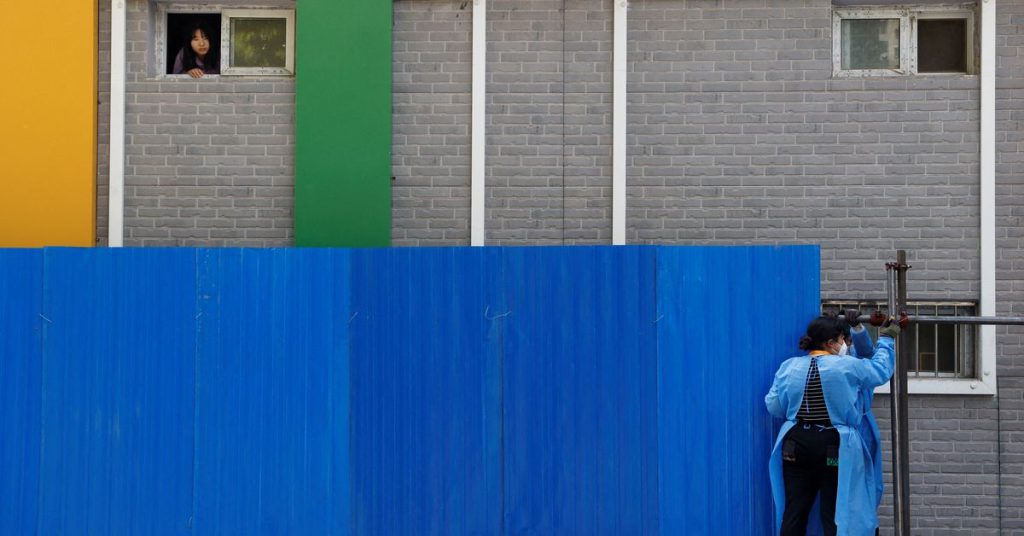BEIJING/SHANGHAI (Reuters) – Beijing closed dozens of metro stations and bus lines and expanded COVID-19 restrictions on many public places on Wednesday, and efforts focused on avoiding the fate of Shanghai, as millions are under a strict lockdown of more. of a month.
The central city of Zhengzhou earlier also announced restrictions, joining dozens of large population centers under some form of lockdown as China seeks to eradicate a virus believed to have first emerged in the city of Wuhan in late 2019.
The data shows that that relentless fight is undermining its growth and hurting international companies investing there, as well as sparking rare public outbursts of discontent.
Register now to get free unlimited access to Reuters.com
With dozens of new cases a day, Beijing hopes that mass testing will detect and isolate the virus before it spreads. Twelve of the city’s 16 districts conducted the second of three rounds of testing this week.
The city of 22 million people on Wednesday shut down more than 60 subway stations, about 15% of the network, and 158 bus routes, mostly in Chaoyang District, the epicenter of the outbreak in Beijing, service providers said.
Beijing officials also said the closures of schools, restaurants, gyms and entertainment venues – as well as some businesses and apartment buildings – would extend beyond the May Day holiday from April 30 to May 4, without specifying a time frame. Read more
Residents were encouraged to work from home from Thursday, instead of returning to offices where possible.
Late Tuesday, Zhengzhou, home to 12.6 million people and the factory of iPhone maker Foxconn (2354.TW), announced work-from-home and other COVID restrictions for the week ahead. Foxconn said on Wednesday it was continuing production there. Read more
Meanwhile, in Shanghai, a full lockdown is still in effect.
More than a month later, most people in China’s largest city are still unable to leave their apartment complexes.
Some have benefited from the temporary easing of restrictions since Sunday, when usually only one family member is allowed out for walks and grocery shopping.
The latest data showed Shanghai found 63 new cases outside of areas under severe restrictions, suggesting it has a long way to go before reaching the multi-day zero-case goal to significantly ease restrictions.
The isolation has led to a cat-and-mouse game between censors and social media users who strive to keep evidence of hardship circulating. Some have turned to blockchain technology to protect videos, photos, and artwork on the topic from deletion. Read more
Such acts of defiance are embarrassing for the ruling Communist Party in a year in which President Xi Jinping is expected to secure a third term in office.
Authorities say their COVID-free policy aims to save lives, pointing to the millions who have died from the virus outside China, as many countries adopt a “live with COVID” strategy amid the spread of infection.
But politics is hurting domestic consumption and production, disrupting global supply chains and slashing revenue for global brands including Apple (AAPL.O)father of Gucci Keyring (PRTP.PA) And the owner of Taco Bell Yum China (9987.HK). Read more
Capital Economics has estimated that COVID has spread to regions that generate 40% of China’s production and 80% of its exports, while Fitch Ratings lowered its 2022 GDP growth forecast to 4.3% from 4.8%, well below China’s official target of 5.5%.
Several factories have been closed after Shanghai was closed from March. While some are beginning to reopen, getting workers back and unblocking supply chains has proven difficult. Read more
Xinhua News Agency reported that 252 companies, or 52% of the total, had resumed work in the city’s Lingang Free Trade Zone, as of May 3. She added that the authorities support the testing of workers for the Corona virus, and provide exemptions from rents.
International trade is also facing turmoil.
A study by the Royal Bank of Canada found that a fifth of the global fleet of container ships are stranded in ports. Read more
And in the port of Shanghai, 344 ships were waiting to dock, an increase of 34% from last month. The study said it takes 74 days longer than usual to ship something from one warehouse in China to another in the US.
Register now to get free unlimited access to Reuters.com
Reporting on Aizhou Chen, He Xiang Ming, Brenda Goh and the Beijing and Shanghai offices; Written by Marius Zacharia. Editing by Robert Percell and John Stonestreet
Our criteria: Thomson Reuters Trust Principles.

“Writer. Evil travel maven. Avid creator. Proud beer expert. Music lover. Explorer.”











More Stories
Jake Sullivan meets Yang Jiechi in Luxembourg, paving the way for a possible meeting between Biden and Xi
The CDC adds 3 places to its “high” risk list, including Mexico and the United Arab Emirates
Wordle 359 June 13 – Struggling with Wordle today? THREE CLUES TO HELP ANSWER | Games | entertainment